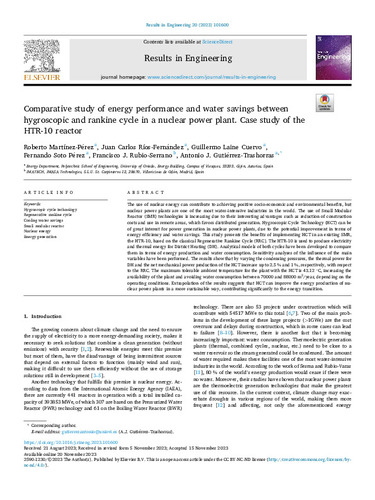Comparative study of energy performance and water savings between hygroscopic and rankine cycle in a nuclear power plant. Case study of the HTR-10 reactor
Palabra(s) clave:
Hygroscopic cycle technology
Regenerative rankine cycle
Cooling water savings
Small modular reactor
Fecha de publicación:
Editorial:
Elsevier
Versión del editor:
Resumen:
The use of nuclear energy can contribute to achieving positive socio-economic and environmental benefits, but nuclear power plants are one of the most water-intensive industries in the world. The use of Small Modular Reactor (SMR) technologies is increasing due to their interesting advantages such as reduction of construction costs and use in remote areas, which favors distributed generation. Hygroscopic Cycle Technology (HCT) can be of great interest for power generation in nuclear power plants, due to the potential improvement in terms of energy efficiency and water savings. This study presents the benefits of implementing HCT in an existing SMR, the HTR-10, based on the classical Regenerative Rankine Cycle (RRC). The HTR-10 is used to produce electricity and thermal energy for District Heating (DH). Analytical models of both cycles have been developed to compare them in terms of energy production and water consumption. Sensitivity analyses of the influence of the main variables have been performed. The results show that by varying the condensing pressures, the thermal power for DH and the net mechanical power production of the HCT increase up to 2.5 % and 1 %, respectively, with respect to the RRC. The maximum tolerable ambient temperature for the plant with the HCT is 43.12 °C, increasing the availability of the plant and avoiding water consumption between 70000 and 88000 m3/year, depending on the operating conditions. Extrapolation of the results suggests that HCT can improve the energy production of nuclear power plants in a more sustainable way, contributing significantly to the energy transition.
The use of nuclear energy can contribute to achieving positive socio-economic and environmental benefits, but nuclear power plants are one of the most water-intensive industries in the world. The use of Small Modular Reactor (SMR) technologies is increasing due to their interesting advantages such as reduction of construction costs and use in remote areas, which favors distributed generation. Hygroscopic Cycle Technology (HCT) can be of great interest for power generation in nuclear power plants, due to the potential improvement in terms of energy efficiency and water savings. This study presents the benefits of implementing HCT in an existing SMR, the HTR-10, based on the classical Regenerative Rankine Cycle (RRC). The HTR-10 is used to produce electricity and thermal energy for District Heating (DH). Analytical models of both cycles have been developed to compare them in terms of energy production and water consumption. Sensitivity analyses of the influence of the main variables have been performed. The results show that by varying the condensing pressures, the thermal power for DH and the net mechanical power production of the HCT increase up to 2.5 % and 1 %, respectively, with respect to the RRC. The maximum tolerable ambient temperature for the plant with the HCT is 43.12 °C, increasing the availability of the plant and avoiding water consumption between 70000 and 88000 m3/year, depending on the operating conditions. Extrapolation of the results suggests that HCT can improve the energy production of nuclear power plants in a more sustainable way, contributing significantly to the energy transition.
ISSN:
Patrocinado por:
This work has been supported by the project "Improvement of energy performance of the Hygroscopic Cycle for power production from the Agencia Estatal de Investigación, Ministerio de Ciencia e Innovación, Spain (ref. PID2019-108325RB-I00/AEI/10.13039/501100011033); and “Severo Ochoa” grant program for training in research and teaching of the Principality of Asturias – Spain (BP20-176). The authors also want to acknowledge the contribution of the Spanish company IMATECH (IMASA TECHNOLOGIES), owner of the Hygroscopic cycle pilot plant, as well as the support from the University Institute of Industrial Technology of Asturias (IUTA), financed by the City Council of Gijón, Spain.
Ficheros en el ítem





